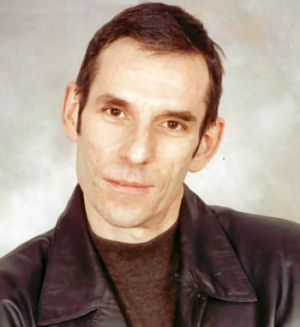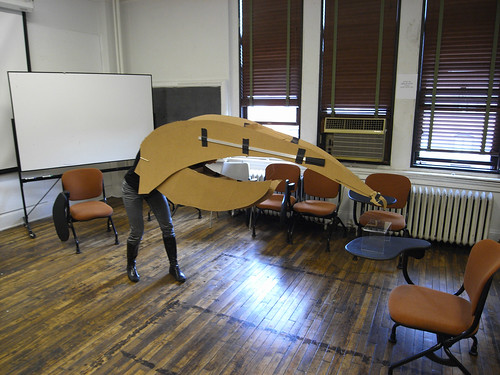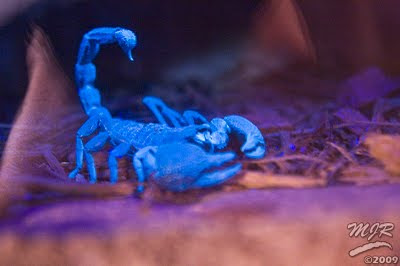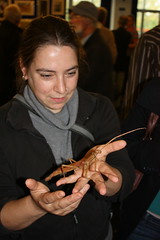Notes from my experience breeding and studying a wide variety of different invertebrates.
Thursday 31 December 2009
Octopus carries coconut shell for protection
Friday 25 December 2009
Rearing Haaniella scabra
Wednesday 9 December 2009
Tuesday 8 December 2009
Monday 7 December 2009
Sunday 6 December 2009
Congratulations to the National Lobster Hatchery

Saturday 5 December 2009
The Cameraman's Revenge
Although the music was recorded in 2008, this film was made in 1912. Thanks to Bug Girl for the link: Vintage Entomology film!
Wednesday 2 December 2009
Invertebrate Rearing journal
Monday 30 November 2009
Sunday 29 November 2009
Peacock Spider

It can raise a pair of legs and fan out two brightly patterned flaps at the back of its body.
Displaying its spectrum of shades in an attempt to attract the attention of the less vibrant brown spiders, the creature reveals hues of orange, yellow, green and blue.
Also known as a Maratus Vilans, amateur photographer Jurgen Otto originally spotted the colourful creature in the wild.
However, as it is only 4mm long, he found it easier to capture images in his Sydney home.
The spider also uses its third pair of legs in the mating display, raising them to show a brush of black hairs and white tips.
The spider can also jump, but the common belief that it can use its patterned flaps to glide through the air is an urban myth which has been debunked by the Australasian Arachnological Society.
The spider is found in eastern parts of Australia, including Queensland and New South Wales.
Both sexes of the spider rarely reach more than 5mm in body length. Females are brown with no distinct pattern."
Presents for Entomologists
Monday 23 November 2009
Leaf cutter ants and bacteria
Sunday 22 November 2009
Poecilimon sp.: Orthoptera from Turkey
Spider Smuggling
Saturday 21 November 2009
Invertebrate Rearing journal
Saturday 7 November 2009
Wildlife Photographer of the Year 2009
 On the 27th October 2009 (yet another timely post) I visited the Wildlife Photographer of the Year preview at the Natural History Museum, London. This year the exhibit has moved to a different gallery, giving it a bit more breathing room and has a more modern feel with blue lighting - it all looks very impressive.
On the 27th October 2009 (yet another timely post) I visited the Wildlife Photographer of the Year preview at the Natural History Museum, London. This year the exhibit has moved to a different gallery, giving it a bit more breathing room and has a more modern feel with blue lighting - it all looks very impressive.

Mating Barnacles Video
Mating barnacles from Casey Dunn on Vimeo.
For more information about barnacle mating check out Mating when you are stuck to a rock by Creature Cast.
Have you got a good marine invertebrate blog post?
Tuesday 3 November 2009
The AES Exhibition
Every year the Amateur Entomologists' Society has an exhibition where you can buy all kinds of live and dead insects, and all the equipment that goes with having an interest in either or both.
As usual I was tied up with helping the Phasmid Study Group and Blattodea Culture Group for a lot of the time (which is fun but doesn't always leave time to have a good look around the rest). One of the people who stopped by to chat was Erica (responsible for the Curator of Diptera's blog). She can be seen here with the phasmid Anchiale maculata.
Somewhat surprisingly I only took two photographs - the Flickr set could just as easily have been called dipterists meeting phasmids really.
Monday 26 October 2009
Sunday 25 October 2009
New U of I Entomology Blog

Snail Porn

The non-safe version of above image

The non-safe version of above image
Yes, it seems that the internet really does have everything you had no desire to find......
Culture List
Saturday 24 October 2009
Mail Eating Snails
FHM Cockroach

Friday 23 October 2009
Penis Eating Worm
Common name: Bobbit worm
Scientific name: Eunice aphroditois (Pallas, 1788)
Origin: Indo Pacific and Western Central Atlantic.
Size: Around 100cm/39", but potentially as large as 3m/10'.
Diet: Lives in soft substrates with its head protruding and feeds on live fish which it detects using a number of sensory antennae on its head. Prey and grabbed in its powerful jaws and then the worm rapidly retreats into its burrow to consume the prey.
Notes: Said to breed at a size of just 10cm/4", which is very early given the size and age of larger specimens. It has an protrusible proboscis, rather like that of the native British ragworm.
Some claim that there may be several related species masquerading under the scientific name Eunice aphroditois, including E. tentaculata.
Thursday 22 October 2009
A trip to London Zoo
Friday 16 October 2009
Spider on Passiflora edulis
Saturday 10 October 2009
iPhone Mosquito Repellent

AES Annual Exhibition
Monday 5 October 2009
Phasmids in Badas Peat Swamp Forest
Tuesday 29 September 2009
Nauphoeta cinerea nymphs
The Nauphoeta cinerea I received from Mark Bushell at the last Phasmid study Group meeting are really starting to fly. I managed to catch this group of nymphs before they "coloured up" (the exoskeleton is soft when the nymphs emerge and as it hardens it develops the usual brown colour).
This brief white phase also occurs after the insect moults. I have seen several "albino" cockroaches on Flickr and elsewhere where people have seen a freshly moulted cockroach on display. My favourite was when I corrected somebody (I believe on DeviantArt). Their photograph showed a freshly emerged cockroach with it's moult (normal coloured) and other non-albino cockroaches. He replied saying that the display said it was of albino cockroaches. Liar!
Monday 28 September 2009
A Diptera Blog
Sunday 27 September 2009
The Great Pretenders
Sunday 20 September 2009
Falkland Islands Dependencies Invertebrate Stamps
Saturday 19 September 2009
Nature Live: The Great Pretenders
I will be giving the talk this Monday at 12:30 and on Sunday, 8th November at 12:30 and 14:30. For more information see The Great Pretenders on the NHM website.
A video of my previous talk can be seen at a previous post: The Great Pretenders.
Name your own wasp

The Natural History Museum and The Times are joining forces to let you name a new species of wasp. More details here: Give a wasp a name.
Natalie Jeremijenko: Human-Beetle Interface
Pestival: Insect Detectives

 There was live adult blowflies on display and a display of other insects associated with decomposing bodies.
There was live adult blowflies on display and a display of other insects associated with decomposing bodies.Thursday 17 September 2009
Butterfly Confetti
After the building was opened by HRH Prince William of Wales thousands of red butterflies came fluttering over the Cocoon. This photo shows some making their way down the outside.
There are more photos of this on my Flickr.
DC2 Opening Butterfly
This photo is from the opening ceremony of the Darwin Centre (Phase 2) at the Natural History Museum, London. This building will contain a large proportion of the dry entomology and botany collections (17 million insects and 3 million plants).
The building was officially opened by Sir David Attenborough and HRH Prince William of Wales (who both missed this piece of theatre). More to come soon.
Thursday 10 September 2009
Not-Doings (by Jane Wafer)
Pestival Symposium: How Insect Are We?
 I am always slightly suspicious about the boundary or art and science. It can be great, such as Fred Edwards' work on Alfred Russel Wallace or Tessa Farmer's The Horned Skullship (shown at the main Pestival event at the South Bank Centre - I will blog about this later ).
I am always slightly suspicious about the boundary or art and science. It can be great, such as Fred Edwards' work on Alfred Russel Wallace or Tessa Farmer's The Horned Skullship (shown at the main Pestival event at the South Bank Centre - I will blog about this later ). The first talk by Stanford University ant biologist Deborah Gordon (of Gordon Lab) was a good start. She covered some examples of ant behaviour (they're lazier than most people believe) and society structure (it's not much like ours). There is a great video of Deborah giving a TED talk here (parts of which are very close to her Pestival talk): Deborah Gordon digs ants.
The first talk by Stanford University ant biologist Deborah Gordon (of Gordon Lab) was a good start. She covered some examples of ant behaviour (they're lazier than most people believe) and society structure (it's not much like ours). There is a great video of Deborah giving a TED talk here (parts of which are very close to her Pestival talk): Deborah Gordon digs ants.Deborah's conclusion was that we really aren't that much like ants.
 The second speaker, the very eloquent Steve Connor (Professor of Modern Literature and Theory at Birkbeck College, London), spoke about flies - 'The Times of Our Lives' - showing how they had made appearances in art and literature for centuries. Being an enlightened chap he has made the text of his talk (PDF) available here.
The second speaker, the very eloquent Steve Connor (Professor of Modern Literature and Theory at Birkbeck College, London), spoke about flies - 'The Times of Our Lives' - showing how they had made appearances in art and literature for centuries. Being an enlightened chap he has made the text of his talk (PDF) available here.Steve did at one point come up with an amusing measure of how insect we are: we are genetically 98% identical to a chimpanzee and 40% the same as a banana, therefore we are between 40% and 98% insect.
 In the third talk Simon Laughlin (Professor of Neurobiology, Department of Zoology, University of Cambridge) showed how the neural networks in the eyes of flies used to identify roll during flight can be used a basis for studying the more complex networks present in humans.
In the third talk Simon Laughlin (Professor of Neurobiology, Department of Zoology, University of Cambridge) showed how the neural networks in the eyes of flies used to identify roll during flight can be used a basis for studying the more complex networks present in humans. Finally engineer and designer Natalie Jeremijenko spoke about some methods she uses to promote conservation in cities and also about her work on interfacing with insects in their own way (in the photo below a human is wrestling a large beetle - from the beetle wrestling page).
Finally engineer and designer Natalie Jeremijenko spoke about some methods she uses to promote conservation in cities and also about her work on interfacing with insects in their own way (in the photo below a human is wrestling a large beetle - from the beetle wrestling page).You can read more about Natalie's projects here.

In conclusion there was no agreement about how insect we are. In fact this issue was only really skimmed over by the speakers - but that's for the best as the question is actually pretty useless. What is good is that it bought some people together, who had a good time. The best answer heard all evening was essentially that we are half a billion years different from insects.
Tuesday 8 September 2009
Tegenaria duellica
This species feeds on small invertebrates, building a flatish nest with a funnel where the spider lurks waiting to inject its prey with venom. This species is not known to bite humans.
Towards the end of summer males are often seen roaming in search of a female to mate with - which is probably the case here.
Thursday 3 September 2009
Stick Insects at Heligan
Wednesday 2 September 2009
Lost Land of the Volcano
A preview of the new BBC series Lost Land of the Volcano (starring George McGavin). There is a great shot of a stick insect around 0:16.
Sunday 30 August 2009
Not the Heaviest Insect
 Several news sources, mainly in Australia, have been reporting that a Macropanesthia cockroach (the one pictured is called Heathcliffe) may be a contender for heaviest insect in the world.
Several news sources, mainly in Australia, have been reporting that a Macropanesthia cockroach (the one pictured is called Heathcliffe) may be a contender for heaviest insect in the world.THIS IS NOT TRUE (at all). These cockroaches can sometimes approach a weight of 40g. The heaviest recorded phasmid (Heteropteryx dilatata) exceeds this weight regularly. Additionally many beetles weigh in excess of 50g, and some even 100g, so poor Heathcliffe has absolutely no chance at the title.
It is a pretty amazing cockroach though.
Wednesday 26 August 2009
I get SPAM....
Monday 24 August 2009
New York Cricket Crawl
 This sounds like a pretty neat event. On the 11th September (or 12th if the 11th is called off due to rain) from 19:45 you can go out and listen to the 7 orthopterans found within New York City.
This sounds like a pretty neat event. On the 11th September (or 12th if the 11th is called off due to rain) from 19:45 you can go out and listen to the 7 orthopterans found within New York City.Jellyfish Mix the Oceans
This video shows a luminescent dye being delivered into the path of a swimming jellyfish. As the jellyfish swims through the dye you will notice that it "carries" some of the dye along behind it. The dye is not actually carried, but "follows" the jellyfish as its forward movement causes a low-pressure area behind it that the dyed water moves in to equalise.
Thursday 20 August 2009
My Unbirthday Card
As I was away for my birthday (in the New Forest) my friend and colleague Natalie constructed me this unbirthday card, expressing in symbols our joint frustration at entomological common names. Small prizes awarded to anyone who makes cool equations (with pictures) along the same lines. If need be e-mail them to me edwbaker {at} gmail [dot] com.
Cockoaches and Mites

"Thinking of keeping a giant roach as a pet? Make sure it's infested with beneficial parasites firs" from PopSci.
Aeshna mixta (Migrant Hawker)
Thursday 6 August 2009
If you go out in the woods today....
I have only ever once encountered a couple in flagrante while out in the wild. It wasn't pretty.
Monday 3 August 2009
Phyllium giganteum

National Geographic has a piece on 'The Art of Deception' in it's latest issue. I identified this species for them, and another that they didn't use (like the quotes I provided). Oh well, here I make a pathetic, needy claim for minor credit! Check out more photos here.
ShareThis
Copyright Ed Baker


























